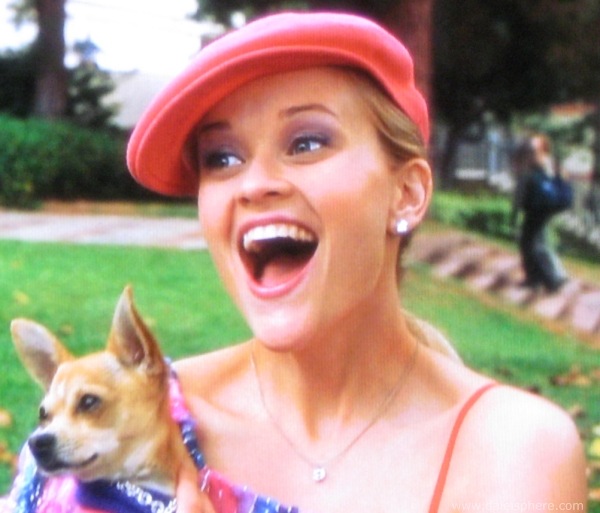 |
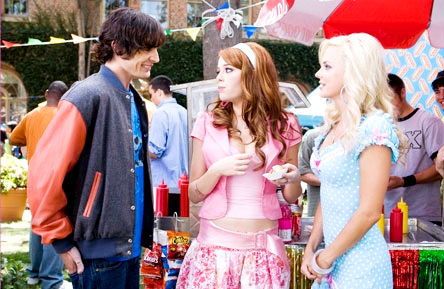 |
Semiology is the basic study of signs. According to Jean Mitry, "A film is clearly something other than a system of signs and symbols... A film first and foremost comprises images, images of something. A system of images that whose purpose is to describe, develop and narrate an event or series of events," (25). In Legally Blonde and The House Bunny, there are many signs present that create an overall message. The narratives of both films are obviously told from a woman's perspective and its signs are targeted toward women in the age range of the late teens and early twenties. The titles, in themselves, already signify that this story is about to be told by women. Legally Blonde's title hints that someone who is blonde will be narrating its story. The House Bunny's title does not hint at a blonde, but that of a Playboy Bunny. According to Anne Friedberg, "Identification with a film star does not entail a cognitive choice, but it draws upon a repertoire of unconscious processes," (36). The films' main characters are young and beautiful well-known actresses that many women may relate to or aspire to be like. These factors are used as appellation to draw the audience's interest.
 |
 |
Warren Buckland says, " Studying film from a semiotic perspective does not involve comparing it to natural language (although this is one of the secondary consequences of conducting a semiotic analysis of film), but involves first and foremost analyzing film's specificity," (6). There are many specific signs in the film that convey messages for the audiences to decode. The sign, or "the basic unit of language," consists of two parts, the signified and the signifier. The signified cannot work without the signifier, and vise-versa. The signified is "a concept or and object," and the signifier is "a sound or image that is attached to the signifier," (Rose 79). Elle's world, including the people in her life and her environment, works to bring forth different signs. Her image is iconic because her images appear like the concept it is signifying (Rose 83). The other people in her life will either help you overcome the obstacles (protagonists), or people who help to create the obstacle itself (antagonists). For example, Warner, her boyfriend at the beginning, can be viewed as an antagonist. He helps to create a couple of obstacles in her life. However, if it were not for his attitude towards her, she might not have had the determination to follow through. Paulette, Elle's manicurist/friend who stood firmly by her, is an example of a protagonist.
 |
Narratives of films usually bring forth many ideological views. Legally Blonde is a film guilty of representing ideologies dealing with gender and class. The signs in the film point toward the idea that upper class blonde, Caucasian females, in their early twenties, behave this way, but it can be changed if you try hard enough. The general stereotype of a blonde female is dumb or ditsy. According to stereotypes, Elle's blondeness is a signifier of being unintelligent, the signified. In the beginning, the film this stereotype was supported. For example, Elle was extremely naive to believe that Vivian, as Warner's new fiancee, would befriend her. Elle believed that Vivian had invited her to a costume party, and arrived in a Playboy Bunny costume. The Playboy bunny costume is a highly sexual choice of garments. Elle presented herself as an object to her peers. Arriving in that costume confirmed, to them, that she was ditsy. Bunny ears of the costume are the signifiers and the signified is Playboy Bunny image. The fur, the corset, and the pink sheer stockings all signify feminine sexuality. With the signifiers and signifieds working together, a message of a beautiful, passive, and sexual woman is conveyed. |
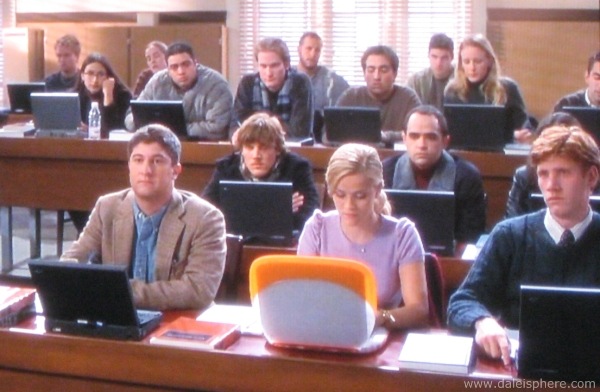 |
As time progressed, the stereotype gradually diminished. Elle finally realizes that she was more than good looks. She began to study hard and participate in her classes. She in seated in front of her classes, towards the center. The computers are signifiers; technology and education are signifieds. The students, books, and the desks are also signifiers of technology and education. By Elle placing herself in the center of this environment, she is challenging the stereotype of being incompetent and ditsy. In the courtroom, the judge, the attorneys, the jury and the placement of the citizens all signify a trial is being held. This leads into another example of Elle challenging the hegemonic norms of blondes is when she takes the lead in court. Brooke fires Callahan for disrespecting Elle and hires Elle to be her attorney. In her cross-examination of the victim's daughter, Elle takes the lead, and is no longer the passive 'dumb' blonde. Now, Elle stands as an active and logical attorney about to win her first case. She stands strong, firm and confident while doing so. |  |
Although the main message may appear clear, there can be another reading taken from the images and actions of the characters. Buckland says, "Semiotics is premised on the hypothesis that all types of phenomena have a corresponding underlying system that constitutes both specificity and intelligibility of those phenomena," (7). Films are definitely polysemic, meaning they have multiple readings and/or meanings. Another reading of this film could be that blonde women are not incompetent. Elle is used as a symbol that conveys this message. Multiple meanings can arise from anything. However, the producers use anchorage in order to get the preferred meaning across. Mitry says, that a narrative's placing "can only be apparent through successive shots themselves places relative to each other in respect of the narrative flow," (183). Narratives are anchored through camera shots.
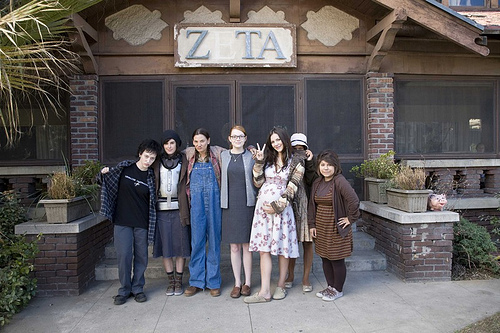 |
The mislaid ZETA sign placed on the house is a signifier of a broken sorority/sisterhood. The dead plants and other drab decoration for the house are signifiers of home that is unpleasant, and boring. the appearance of the Zeta house detoured girls from wanting to join them. The girls' appearance alone, detoured people from wanting to even associate with them. They looked dull and scary, just like their home. Later, once the girls realized thier true potential, their appearance changed. The ZETA sign was replaced, signifying a repaired sisterhood. The decor signify fun and bright signifieds. The confettii blowing everywhere aare signifiers of happyiness and the party life, which are all factors very important to Greek life. | 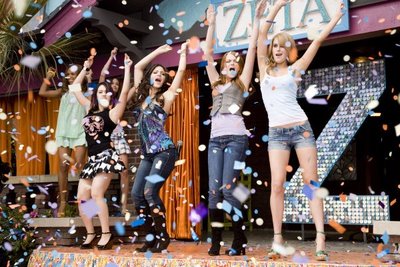 |
In The House Bunny, the main message appears to tell spectators to be themselves, and in the end you will always come out on top. However, another reading of the message can be that you must alter yourself slightly, in order to come out on top. Shelly gave the Zeta girls makeovers that they decided to redo. Even though they chose to keep half of Shelly's look and half of themselves, they still had to make alterations to their appearances. Before, these girls were plain and physically unattractive, but on the inside they were amazing people. It was not until they changed that people gave them attention and wanted to get to know the real them. The aesthetics of these two films plays a huge role in conveying messages. Aesthetics is "the meaningfulness of art (and life) as apprehended through the senses; the beauty of art and the sensual enjoyment it engenders," (Ott & Mack 116).
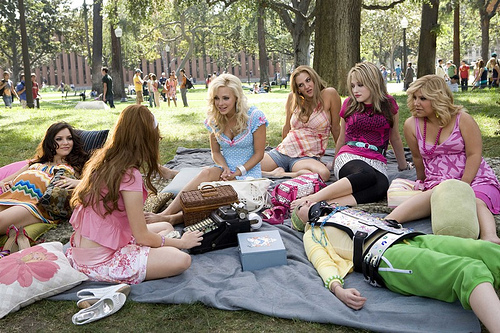
W. Hesling says, "Metz considered the cinematic institution not only as a film-industrial constellation, but also as a "mental machinery" absorbed by the public. This mental machinery consists of the ideological characteristics of the Hollywood cinema..." (182). Furthermore, films have direct effects on its spectators. Sometimes they leave us thinking, and others give clear messages. Some even give us false hopes and make us desire to change ourselves, which could be a good or bad change. The apparatus theory states that "the actual environment and machinery of the cinema activates a number of psychoanalytic desires within the spectators," (Ott & Mack 159). Other times, films affect spectators without them even being aware of it. The new desires we attain are repressed and stored in our unconscious. Later, they may be interjected in our conscious lives (Ott & Mack 152). These two films can be read in various ways and send different messages depending on the spectator. They seem to objectify women in a way that teaches lessons and morals. They use objectification to show the passive and emotional stereotypes and how awful they appear. Then, they challenge these stereotypes and give the impression of empowerment to women. They are good examples of how films can send messages that empower women and give them subjectivity, instead of objectifying them.